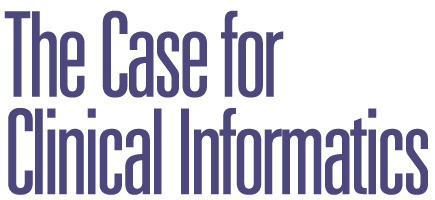
David McCallie of the Cerner Corporation has this vision. As he sees it,
the emerging science of genomics will synthesize with the rapidly developing
technology of medical informatics to create a dynamic new hybrid field
he calls "clinical informatics." Although he fears that the
normal dysfunctions of bureaucracy will fragment "the informatics
community," he sees no need or reason for this to happen.
This vision, McCallie humbly admits, is not unique to him. It’s just
that as the vice president for Medical Informatics at the world’s
leading developer of clinical information systems, McCallie is uniquely
poised to bring the vision to life.
Already Cerner has made huge strides towards what McCallie calls "personalized
medicine." More and more, health-care providers are able to access
critical and specific patient information from a completely integrated
and standardized electronic health record and apply this infor-mation
to the care of the patient.In fact, Cerner’s "Health Network
Architecture" (HNA) now facilitates the electronic sharing of information
among clinical disciplines in more than 1,300 sites worldwide.
As prices drop and options expand, physicians are more likely to employ
this technology at the bedside through the so-called personal digital
assistant, or PDA. It is estimated, in fact, that some 15 percent of physicians
are currently using this handheld wireless technology for reference purpose,
and that by 2004, 20 percent of physicians will be using it for ordering
and checking lab tests, capturing charges, dictating notes and ordering
prescriptions. These systems, of course, save time and money. But through
their precision and timeliness, they also have the potential to save lives
and preserve health.
Not surprisingly perhaps, the most active users of handheld wireless systems
are doctors in small group practices outside of hospitals. Many among
them have taken advantage of vendors’ offers for free PDAs. Given
the resources of pharmaceutical corporations and pharmacy benefit management
groups, which help fund these programs, a growing number of software companies
are introducing such offers, and their success is overwhelming.
For all their virtues, and they are many, McCallie believes that these
existing forms of medical informatics may well represent just the beginning
of a new era in health-care delivery. As of now, they basically serve
to integrate existing information drawn from a variety of traditional
sources. McCallie would like to see these systems routinely integrate
the person’s individual genomic history as well.
Genomics is often discussed but not well understood by the public. For
the record, "genomics" is defined as the investigation into
the structure and function of a very large number of genes undertaken
in a simultaneous fashion. The term "genome" dates back to 1930
and was used to denote the totality of genes on all chromosomes in the
nucleus of a cell. The notion of DNA, which now seems so commonplace,
was not identified as the genetic material of all living organisms until
1944. Incredible as it seems, the sequence of these genes encodes all
of the information needed to specify the entire reproduction, development
and adult function of an individual organism.
As to the genetic code, that was not delineated until 1961. But almost
immediately, researchers began to contemplate the possibility of devising
a genetic blueprint of an entire living organism, the human person included.
The complete sequencing of the human genome was proposed in 1986, and
the resulting large-scale initiatives, collectively known as the human
genome project, were launched in 1990 with support from the National Institute
of Health and the Department of Energy.
America, Kansas City included, has invested deeply in these projects in
the belief that genomics will be the single most fruitful approach to
the acquisition of new information in basic and applied biology in the
next several decades. It is the "applied" part that has caught
McCallie’s eye and that of many of his colleagues in the life sciences
movement.
According to McCallie, there are two basic ways that the genomic revolution
can interact with medical records. The first, and most obvious, benefits
the individual. Aware of the individual’s genetic record, the physician
will have a much keener awareness of patients’ susceptibility to
environmental toxins, their receptivity to given drugs, their aging patterns,
and their ability to cope with the traditional "enemy"—the
various viruses and bacteria that literally plague mankind. The entire
care plan, in fact, could be personalized around the individual’s
genetic makeup. The vision that McCallie describes is futuristic only
in the application.
The recording of this information, however, also has the potential to
advance medical research and in the process improve the health of the
community writ large. If the individual’s genetic data are transferred
instantly and electronically to a generalized database for study, researchers
will be able to draw inferences about a wide range of medical interactions.
In the way of example Cerner is now involved in a research project with
the University of Illinois at Chicago. There researchers are analyzing
the DNA variations among AIDS patients to help physicians select treatment
plans that will prove most efficacious for the individual. The information
gleaned and categorized will enable physicians elsewhere to understand
in advance how certain AIDS drugs interact with certain genetic types.
In the future, as McCallie envisions it, medical workups will draw as
much if not more from genetic analysis as they do today from laboratory
tests. Cerner’s role in all of this will be to create the technology,
certainly the software, that translates raw data into useful information,
quite possibly at the patient’s bedside. Where this all leads, McCallie
can not be certain, but wherever it goes, he is confident that Cerner
will be at the forefront."